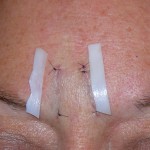The most common cosmetic treatment of the glabellar region is that of Botox injections. By decreasing the effects of the procerus and corrugator muscles, the creation of vertical glabellar wrinkles or furrows is diminished. But Botox only treats dynamic dynamic wrinkling and will not change static wrinkles which represent the long term effects of unrestrained dynamic glabellar muscle action.
For static glabellar wrinkles/furrows, this is where the role of injectable fillers comes into play. But very deep furrows, which are more of an inverted V shape, respond poorly to the push of injectable fillers because of their contracted indented nature. There is also the risk, albeit rare, of the risk of blindness that has been associated with the use of fillers in this area. An alternative treatment option is that of an implant.
In the December 2014 issue of the Annals of Plastic Surgery, an article was published entitled ‘Correction of Deep Static Glabellar Lines With Acellular Dermal Matrix Insertion’. In this paper the authors inserted a strip of acellular dermal matrix (ADM) underneath deep glabellar wrinkle lines. Over a three year period, thirty patients were implanted and then evaluated using the Lemperle scale for wrinkle depth assessment as well as patient questionnaires. No infections or material complications were seen. They reported that the improvement in the reduction of the depth of the glabellar furrow was sustained for a long time. This clinical study shows that this type of glabellar implant is simple and easy to do as well as effective. For deep glabellar furrows that do not correct well with an injectable filler, implant insertion is another treatment option.

Because the glabellar furrow is a straight line and short, it is easy to thread almost any material into it. Whether any of the mentioned materials is better than another can be debated but all offer some degree of sustained improvement in the deep and problematic glabellar furrow.
Dr. Barry Eppley
Indianapolis, Indiana


